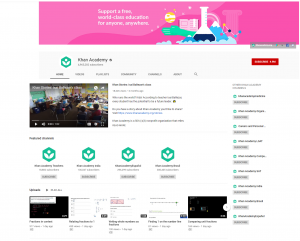
In the podcast “Can Khan Academy Scale to Educate Anyone, Anywhere?” Brian Kenny interviews Bill Sahlman regarding the case he wrote for the Harvard Business Review about Khan Academy, the online global education nonprofit organization whose founder, Sal Khan, says its mission is to “provide a free world-class education for anyone, anywhere.” Khan Academy, which started in 2006, seems to be on the right track to reach its goal, as it is now offering 40 subjects to 15 million monthly visitors from 190 different countries.
Kenny and Sahlman discuss one of the most important features of Khan Academy’s lessons, which is that they “chunk” educational material into videos that run a maximum of 10 minutes each. This is because YouTube, which was the original and still is the main social media platform that Khan Academy uses, originally had that as its maximum play length for videos. While Youtube has since increased their limit, Khan Academy still sticks to the 10-minute rule for their videos as it is incredibly helpful for learning. It accommodates the human brain’s limit for absorbing new information at one time, makes it easier to create educational videos, and create customized lesson plans around these videos. This has helped Khan Academy be one of the few online organizations that is embraced by public school systems, the US College Board, and students from around the world.
This is also the reason why Khan Academy was one of initial partners that YouTube announced for their new Learning Fund initiative. According to Dani Lee in The Verge, the Learning Fund is a $ 20 million program that YouTube is directing towards creators to improve and increase the educational content on the platform. Khan Academy is a trusted partner, meaning it will receive both funding and other support from YouTube to create educational videos that can be added to YouTube’s new Learning Playlist feature, which will be curated around topics such as math, science, music and language. This is especially useful both for people who want to learn on their own, and for educators who want to utilize YouTube videos in teaching their students.
However, there are downsides to Khan Academy’s usage of 10-minute videos on YouTube. Because they are an American company, these videos are primarily in English, often with subtitles available in other languages. However, these still render the videos inaccessible to the millions of learners around the world who do not speak English, particularly if they are unfortunate enough to not have subtitles available in their language. Also, being hosted on YouTube means that the learners become part of YouTube’s data algorithm monster. Their activity might be tracked, and be used to further tweak YouTube’s business practices to make it a more addictive platform. One of the bigger downsides of YouTube, which is its algorithm’s tendency to sometimes recommend videos that contain troubling, inaccurate, or otherwise problematic content while you’re watching videos about a topic, are mitigated by Khan Academy’s presence on the Learning Playlists, which will not have recommended videos or auto-play. I am also personally concerned if ads will be shown in these videos, or if they can be turned off. However, I am excited at what Khan Academy can achieve with their bigger platform and more resources.
Sources:
Kenny, B. & Sahlman, B. (2019, June 18). Can Khan Academy Scale to Educate Anyone, Anywhere? HBR Presents. Podcast retrieved from https://hbr.org/podcast/2019/06/can-khan-academy-scale-to-educate-anyone-anywhere
Lee, D. (2019, Jul. 11). YouTube is launching educational playlists that won’t include algorithmic recommendations. The Verge. Retrieved from https://www.theverge.com/2019/7/11/20690736/youtube-learning-playlists-algorithm-recommendations
